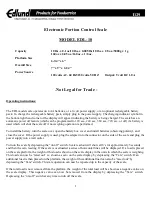
8.0 LOAD CELL DAMAGE
The most common reason a scale fails is that the load cell has been
damaged. The damage can be from 2 primary causes. The first is
physical damage due to an overload or a impact from the side and the
second is damage due to the environment, such as moisture, extreme
heat or a cut cable if the cables are exposed.
PRINCIPLE OF OPERATION
The strain gauge load cell is a method of measuring the amount of stress
put onto a metal structure due to a weight being supported by the
structure. The stress is measured using 4 strain gauge sensors mounted
in a particular way on the metal structure.
These 4 strain gauges are connected in such a way that they form a
wheatstone bridge. See figure below. In the simplest load cells there
are only the 4 resistances of the strain gauges to consider. Normally
without a load on the load cell all the resistances are the same. However
when the load cell has a weight on it 2 of the strain gauges will be in
compression (A and D) and the resistance will decrease and 2 will be in
tension (B and C) and their resistance will increase.
35
0
ohm
35
0 o
hm
35
0 o
hm
35
0
oh
m
A
B
C
D
+E
-S
-E
+S
BALANCED BRIDGE
10 VOLT POWER
SUPPLY
Vout = O VOLTS,
BS AND -s
35
1 o
hm
34
9
oh
m
35
1 o
hm
34
9
oh
m
A
B
C
D
+E
-S
-E
+S
UNBALANCED BRIDGE
FULL CAPACITY LOAD
ON THE LOAD CELL
10 VOLT POWER
SUPPLY
Vout = 0.028 VOLTS (28mv),
BS AND -s
This will cause the bridge to become unbalanced. When the bridge has
a voltage across it from +E to -E then the signal output at +S and -S will
show a voltage of zero volts with no load and a small voltage
proportional to the load as the load is increased. Typical load cells show
20-30mv of signal if the excitation voltage is 10volts and the load cell is
fully loaded.
@Adam Equipment Company 2007
13
Содержание CFC SERIES
Страница 2: ...Adam Equipment Company 2007...
Страница 4: ...Adam Equipment Company 2007 2...
Страница 19: ...Adam Equipment Company 2007 17...








































